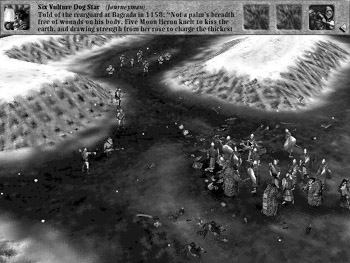Game Focus

Myth s gameplay is entirely focused on tactical combat, leaving out the resource management found in many other RTS games .
Myth is also a good example of a well-focused game design. As mentioned previously, Myth came out several years after the success of two other RTS titles, Command & Conquer and WarCraft. In both of those games, players build structures that exploit the terrain s natural resources in order to create additional units. Players are then able to direct these units against their opponents in a combination of ways. Thus, those trend-setting RTS games are a mixture of gameplay ” part resource management and building, part combat. Many of the subsequent RTS titles, both the successes and the failures, copied this general model, dividing players efforts between unit creation, resource exploitation, and strategic unit deployment.
But Myth does not feature any resources to be mined or structures to be built. Instead players are focused entirely on the tactical side of the game, on the combat experience. Players start out on a level with a given quantity of units, and for most of the levels in the game those are the only units they get for that entire level. In some scenarios, additional units are acquired later in the level, but those scenarios are the exceptions rather than the norm. Myth does away with everything except for the combat elements of RTS games, which gives its gameplay a unique focus.
This tactical emphasis has several ramifications on the overall game design. First, by not needing to worry about developing a resource exploitation system, Jones was able to focus on making the combat model as good as it could be. This resulted in more sophisticated and detailed combat than was found in any other RTS game at the time. In Myth , unit facing , formation, and placement matter more than they had in other strategy titles. Because the developers did not have to worry about how players would use resources, more time could be spent on the physics system and other technologies that would enhance the combat experience. For example, this attention to detail meant that archers needed to worry about finding a clear shot through the trees, how the weather would effect the trajectory of their arrows, and how their vertical placement on the landscape would impact the distance they could shoot.
Players inability to build additional units also affects the care with which they use the units at the start of a level. In WarCraft one can make a very substantial blunder early on in a level and still be able to win by wise resource usage and unit creation. In Myth , such an error is often fatal, with the levels becoming less and less forgiving as the game progresses. Players only recourse when their plan of attack fails is to reload the level. This makes for a very different kind of gameplay than is found in WarCraft. In Myth , players must think through their actions fully instead of just trying whatever first pops into their heads. The units are much more precious and, as a result, players start caring for their welfare. Since more can be made easily, the units in WarCraft may seem like just so much cannon fodder. Conversely, in Myth a particular unit may be crucial to finishing a level, and there is no way to bring him back once he is killed .
EAN: 2147483647
Pages: 189